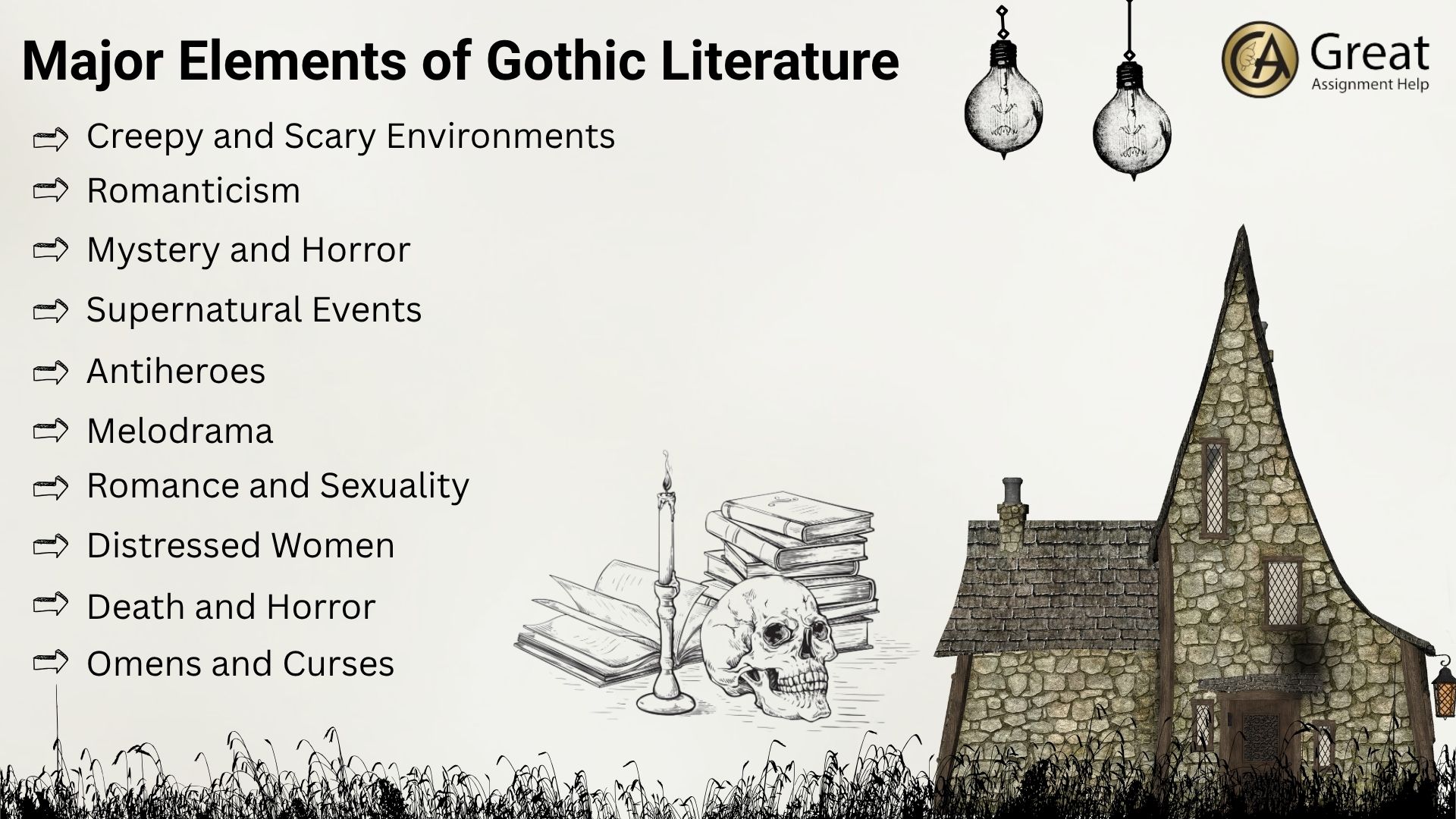Gothic literature is a genre that explores the darker side of human nature. It features haunting settings, supernatural elements, and themes of death. The Gothic stories often create a sense of mystery and suspense to draw readers into a world of horror.
Gothic literature is a genre that investigates the dark aspects of life. It usually contains elements such as horror, death, and the supernatural. It began towards the end of the 18th century and usually leads readers to frightening environments such as ancient castles, haunted houses, and stormy environments. This type of literature examines the human mind, where fantasy and reality meet. The first Gothic novel, “The Castle of Otranto,” written in 1764, opened the way to this genre. Typically, most horror films draw inspiration from Gothic literature and will utilize the same settings and themes to build suspense and terror. As a whole, Gothic literature provides an interesting and engaging reading experience, particularly for those who like dark and romantic themes.
If you are interested in knowing about Gothic literature, then read this blog further. In this article, we have discussed the major characteristics, elements, universal themes, and distinctive features of Gothic literature.
An Overview of Gothic Literature
What is Gothic literature? It is one of the widely used genres that began before the Romantic period and became popular during the late 18th and early 19th centuries. Horace Walpole brought it to England, and it subsequently spread to the US. This genre narrates thrilling and supernatural stories with romantic elements. Gothic writers, compared to Romantic writers, delve deeper into their topics.
Primarily to instill a fearful mood, Gothic tales are set in crumbling castles, desolate mountains, or remote locations. Hidden secrets, ghosts, vampires, and wretched lives with an air of mystery and terror make up the plots. Oftentimes, the characters of Gothic fiction will be intelligent, reclusive, physically impaired, or suffering from mental illnesses.
Another popular motif in Gothic literature is the “Damsel in Distress.” This motif involves a woman who is threatened or trapped in a desperate circumstance. As time passed, Gothic literature developed, and Southern Gothic became a new genre. Novels such as those written by Truman Capote were popularized as Southern Gothic. Subsequently, these novels continued to engage readers through their dark and eerie narratives. Southern Gothic literature is a unique blend of Gothic fiction and Southern American culture. It generally explores themes of slavery, racism, and the experiences of Black people.
Gothic Literature Features
Some of the most notable Gothic authors include Mary Shelley and Ann Radcliffe. Their novels usually draw on elements of horror, romance, and mystery to engage readers. The genre has had a profound influence on contemporary storytelling.
These are the main characteristics of Gothic literature
- Incarnate horror, romance, and mystery to engage readers
- Incorporates dark and mysterious elements, such as derelict mansions and dark forests, to establish fear and suspense
- Takes supernatural creatures such as ghosts, monsters, and vampires
- Tackles intense emotions such as fear, love, anger, and despair
- Does a depiction of flawed and complicated characters
- Typically encompasses grand and costly settings, such as mansions and castles
Distinctive Characteristics of Gothic Literature
The following are some of the prominent characteristics of Gothic Literature
Characters
In Gothic literature, the characters tend to step out of their secure world and end up in unusual and different places. This can result in being isolated and captive. Typically, authors introduce ghosts and supernatural beings to enhance the suspense and mystery.
Place
The place is an important aspect of Gothic fiction. It usually involves aged castles, dark forests, and deserted houses. These locations can merely be physical buildings, but they symbolize the state of mind of the characters as well. Authors sometimes utilize the house or building as a symbol of the internal world of the characters and the mysteries surrounding them.
Atmosphere
Gothic fiction builds a particular atmosphere that attracts readers. Setting, tone, and language all help to achieve this atmosphere. Authors implement suspense, mystery, and conflict to maintain the readers’ interest. The atmosphere is intense and overwhelming. This complicates it for characters to get away.
The Supernatural
Gothic fiction typically contains supernatural entities such as ghosts and monsters. The supernatural, however, at times may only exist within the imaginations of the characters. This uncertainty generates doubt and confusion. Therefore, the narrative will seem even more frightening.
Damsels
In classic Gothic novels, the “damsel in distress” is a typical character. It mostly reveals unequal power between men and women. They generally depict women as being weak. Some women are depicted as supernatural or being evil by some writers of Gothic novels.
Time
Gothic fiction primarily delves into the past and how it affects the present. The past may be sinister and menacing, and it usually clashes with the present in some unexpected manner. This conflict generates fear, danger, and uncertainty. Moreover, it upsets the characters’ perception of reality.
List of Widely Used Themes in Gothic Fiction
Typically, Gothic fiction examines the negative qualities of human emotions and nature. It mostly involves themes such as horror, supernaturalism, and the sublime. Primarily, authors use these themes to convey sophisticated ideas and feelings. This provides tension and suspense in their narratives. In addition, through the integration of literal plot and underlying meaning, Gothic writers make their points engagingly. In general, Gothic literature is characterized by somber and philosophical themes. Some of the most common themes of Gothicism are
- Appearance vs. Reality
- Losing innocence
- Good vs. evil
- Cursed families
- Fear
- Fallen female
- Injustice
- Bad influence
- Isolation and seclusion
- Human weakness
- Unequal power
- Inner struggles
- Oppressed heroine
- Romance
- Searching for the truth
- Madness
Major Elements of Gothic Literature

These are some major elements of Gothic Literature
Creepy and Scary Environments
Gothic works frequently include ominous, abandoned, and deteriorating environments such as old castles, mansions, or churches. Normally, such environments will evoke a terrifying ambiance and render the narrative suspenseful.
Romanticism
Gothic literature blends romance and horror. Mostly, in Gothic tales, people fall in love, but conflicts with their families or histories provide impediments.
Mystery and Horror
Gothic literature seeks to instill fear and suspense in readers. Therefore, Gothic authors typically employ mysterious plots, unresolved questions, and concealed realities.
Supernatural Events
Gothic literature often involves supernatural beings such as monsters, ghosts, vampires, and witches. The presence of such elements in the plot makes the story thrilling and terrifying.
Antiheroes
Gothic literature tends to have complex and blemished characters, referred to as antiheroes. These characters will be morally complex, isolated, and at times manipulated.
Melodrama
Gothic fiction is characterized by powerful emotional content. Primarily, in Gothic fiction, characters have strong emotions, and the action contains dramatic situations such as murders, kidnappings, and insanity.
Romance and Sexuality
Gothic fiction treats passion and sensuality in a repressed manner. Typically, in Gothic stories, women will be presented as submissive and frail, and men will be strong.
Distressed Women
Women characters in Gothic fiction will be depicted as helpless, deserted, and under stress. They will at times be threatened or manipulated by dominating male characters.
Death and Horror
Death is a key motif of Gothic fiction. Gothic writers typically delve into the negative aspects of human nature by including graveyards, gory scenes, and supernatural occurrences.
Omens and Curses
Gothic fiction normally involves bizarre occurrences, enigmatic symbols, and supernatural forces that dominate characters’ lives. Authors introduce curses and omens to build tension and fear and to make the narrative more suspenseful.
Final Words
By now, you will have gained a deeper understanding of elements, themes, and features of Gothic Literature. Having good knowledge of Gothic Literature will make it easy for you to handle your English literature assignments. In case you still have doubts about Gothic literature or if you struggle to write your literature assignments, then quickly approach our team of experts for guidance. As per your needs, the scholarly writers from our platform will offer you the best Literature Assignment Help. Especially with our literary expert support, you can improve your understanding of Gothic literature, finish your assignments on time, and secure top grades.



